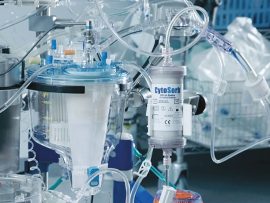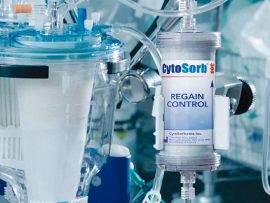Abstract Background: Sepsis and septic shock are major contributors to global morbidity and mortality. The “cytokine storm,” a hyper-inflammatory response, plays a central role in sepsis pathophysiology, leading to multi-organ..
Read MoreAbstract Mixed shock has been identified by the Shock Academic Research Consortium (SHARC) as a “high-risk, understudied population”. It develops in around one-quarter of patients with cardiogenic shock and has a higher..
Read MoreAbstract Sepsis-induced cardiomyopathy is a severe complication seen in patients with refractory septic shock, characterized by cardiac dysfunction due to an overwhelming inflammatory response secondary to infection. Despite its reversible..
Read MoreAbstract Predictive scoring systems for adult patients receiving extracorporeal membrane oxygenation (ECMO) support for sepsis have not been yet reported. Based on the Chinese Society of ExtraCorporeal Life Support (CSECLS)..
Read MoreAbstract Background Sepsis is the result of a dysregulated immune response to infection and is associated with acute organdysfunction. The syndrome’s complexity is contingent upon the underlying pathology and individual..
Read MoreAbstract Sepsis is a dysregulated host response to infection responsible for life-threatening organ dysfunction.1 Along with early antimicrobial administration and source control, correction of hemodynamic derangements is a crucial aspect of..
Read MoreAbstract Physiological hemostasis is a balance between pro- and anticoagulant pathways, and in sepsis, this equilibrium is disturbed, resulting in systemic thrombin generation, impaired anticoagulant activity, and suppression of fibrinolysis,..
Read MoreAbstract Sepsis is a life-changing condition that can occur undergoing . It is characterized by a dysregulated inflammatory response to infection, often leading to higher rates of organ dysfunction and mortality. The..
Read MoreAbstract Sepsis and Tachycardia – Aetiologic Factors During sepsis, the sympathetic nervous system plays a key role in maintaining cardiac output and blood pressure. This is achieved through changes in..
Read MoreThis case reports on a 67-year-old male patient, who was admitted to hospital suffering from a severe immunological response following his 2nd COVID-19 vaccination. [pdf-embedder url="https://perfusfind.com/wp-content/uploads/2022/05/CoW_19_2022_E_web_compressed.pdf"]
Read MoreAbstract Both overfeeding and underfeeding critically ill children are problematic. This prospective pilot study evaluated the resting energy expenditure in infants and children requiring extracorporeal membrane oxygenation (ECMO) support. An..
Read MoreAbstract Background: Extracorporeal membrane oxygenation (ECMO) is increasingly utilized for pediatric sepsis unresponsive to steroids and inotropic support. Outcomes of children with sepsis are influenced by the type of pathogen causing..
Read MoreAbstract Sepsis is life-threatening organ dysfunction caused by a dysregulated host response to infection [1]. Sepsis and septic shock are major healthcare problems, impacting millions of people around the world..
Read MoreAbstract The impact of cervical cannulation on neurologic outcome has not been yet studied among children receiving venoarterial extracorporeal membrane oxygenation (VA-ECMO) in the context of severe sepsis or septic..
Read MoreAbstract Objectives: Evaluating whether there is a clinical benefit of using extracorporeal cytokine adsorption therapy in two indications. Design: Systematic review. Setting: Search on four databases, Medline, Embase, The Cochrane..
Read MoreAbstract Cardiac surgery with cardiopulmonary bypass (CPB) induces an acute inflammatory response that may lead to a systemic inflammatory response syndrome. The interest in procalcitonin (PCT) in the diagnosis of..
Read MoreAbstract Septic shock is a major burden to healthcare with mortality rates remaining high. Blood purification techniques aim to reduce cytokine levels and resultant organ failure. Regarding septic shock, hemoadsorption..
Read MoreAbstract The primary focus of research into the pathophysiology of the acute respiratory distress syndrome (ARDS) has been on the interaction between the lung, underlying causes of ARDS, and the..
Read MoreAbstract Background To identify novel factors associated with the survival of septic adults receiving (ECMO) to improve patient selection and outcomes. Methods Cases were identified from our ECMO registry from 2001..
Read MoreAbstract Background: Aim of this study was to evaluate the outcomes of endocarditis patients undergoing valve surgery with the Cytosorb® hemoadsorption (HA) device during cardiopulmonary bypass. Methods: From 2009 until 2019,..
Read MoreAbstract Background Serum lactate and central venous oxygen saturation (ScvO2) are commonly used and commonly recommended as markers of tissue oxygenation in shock states. Medical literature has both explicitly stated..
Read MoreAbstract It is observed that death rates in cardiac surgery has decreased, however, root causes that behave like triggers of potentially avoidable deaths (AD), especially in low-risk patients (less bias)..
Read MoreAbstract Vascular hyperpermeability is a frequent intractable feature involved in a wide range of diseases in the intensive care unit. The glycocalyx (GCX) seemingly plays a key role to control..
Read More














